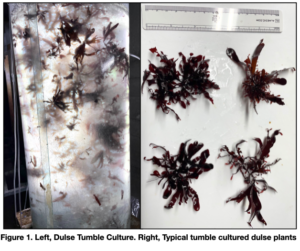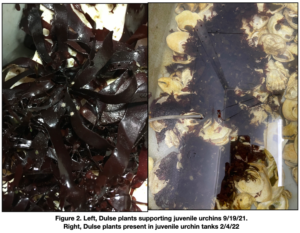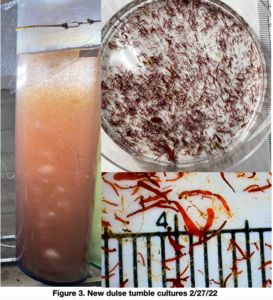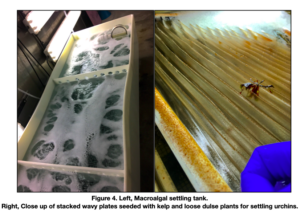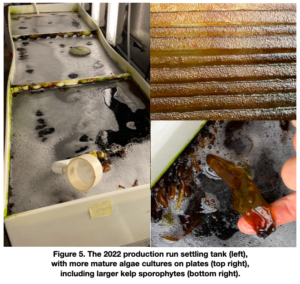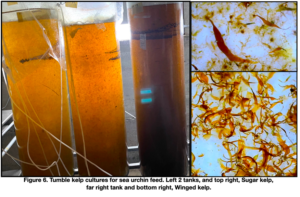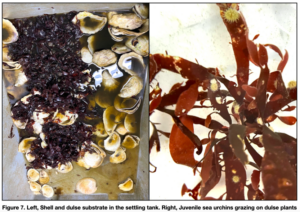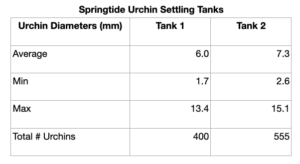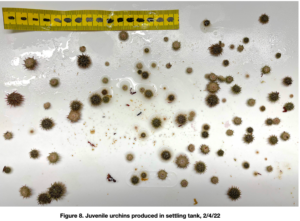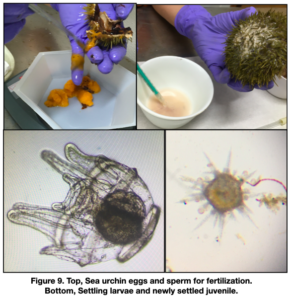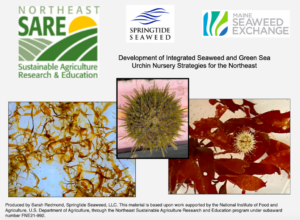Final report for FNE21-992
Project Information
Seaweed and shellfish aquaculture is a fast growing industry in Maine, but most farms rely on only one crop and lack diversification options. Green sea urchins (Strongylocentrotus droebachiensis) represent an opportunity for multi-cropping on aquaculture farms, but there is no commercial source of hatchery-raised seed for the new crop. This project addressed bottlenecks in sea urchin seed production by testing new methods of macroalgal cultivation and integration into the hatchery phase for improved settlement and juvenile survival. Sugar kelp and dulse plants were cultivated in several different systems and integrated into flow-through and static settling tanks. Typical urchin settling plates were successfully spore-seeded with juvenile attached kelp sporophytes to create a rich feed layer for settling urchins. Large tumble-cultured dulse plants were successfully used as both a settling substrate and a feed source for juvenile urchins, producing nearly 1000 seed urchins in two small static settling tanks over 7 months. Work is ongoing to transfer and adapt the sea urchin hatchery protocol and system into a working seaweed nursery, with the first trial run to take place this spring. This project has allowed for essential knowledge transfer between two marine aquaculture centers in Maine, and moves the industry closer to a commercial sea urchin seed hatchery to support the diversification of the aquaculture industry. Springtide Seaweed gave a number of in person and online talks and trainings in 2021. In those trainings, we shared the objectives of this project as a part of the opportunity for integration of sea urchins with seaweed as a part of a future of small-scale local aquaculture.
This project sought to improve post settlement success utilizing seaweed feed produced in the sea urchin hatchery. This is a collaborative effort that sought to bring together urchin and seaweed cultivation expertise to improve urchin hatchery systems.
Objective 1: Develop seaweed cultivation systems for a sea urchin hatchery.
Seaweed cultivation systems for sugar kelp and dulse will be established at the CCAR hatchery. This will enable the UM CCAR hatchery to produce high quality, consistent, reliable macroalgal feed to improve their post settlement hatchery techniques.
Objective 2: Test hatchery raised seaweed feed for improved urchin settlement and recruitment rates.
Test availability of hatchery cultivated macroalgal feed on settlement and recruitment compared to the control, which will help inform hatchery protocols and future research.
Objective 3. Develop a sea urchin hatchery at a commercial seaweed nursery.
Knowledge transfer is critical for aquaculture diversification. CCAR sea urchin hatchery techniques will be transferred to the Springtide nursery and a pilot will be run to produce a crop of urchin seed. This work will lay the groundwork for the development of the first commercial urchin hatchery in Maine.
Once the fastest growing marine fishery in the US, the Maine green sea urchin fishery is another “boom and bust” cautionary tale. While Maine has had a small urchin fishery since the 1930’s, the fishery rapidly expanded in the late 1980’s, peaked in 1993 at 41 million pounds, then declined to 2 million pounds in 2018 (DMR, 2018). Efforts at reseeding wild populations were unsuccessful due to high predation (Leland et al, 2001), and wild stocks have not recovered. The increasing demand for high quality uni (sea urchin gonads), global market of $400 million, and limited wild resource presents an opportunity for aquaculture, but urchin aquaculture represents less than 0.01% of worldwide production (James et al., 2016). The recent increase in small seaweed and shellfish aquaculture farms in Maine and decreases in commercial fishery landings over the past few decades point to a future of aquaculture for seafood production, and the green sea urchin could be a valuable new crop for the future.
Maine has recently experienced an increase in seaweed and shellfish aquaculture leases, with the majority of farms cultivating only one crop. Since 2015, the farmed oyster harvest has increased 84% and the seaweed harvest 1800%, with an increase in the number of new smaller entry farms, or limited purpose aquaculture leases (LPAs) increasing 157%, from 2015 to 2019 (DMR, 2020). Marine aquaculture leases are the most valuable asset to any ocean farmer. In Maine, the standard lease process can take several years, and represents a comprehensive process that requires considerable investment. By integrating new species into a farm, farmers can increase sustainability, profitability, and resilience of a sea farm. Currently, there are only a few crop options for seafarmers, each presenting challenges. Seaweed crops have a low dock value and currently lack sufficient processing and marketing infrastructure, and shellfish farms can be closed from red tide biotoxin events, and crops can take several years to reach market size in the cold waters of Maine.
The major barrier to the commercial development of a new crop is a reliable seed source. The shellfish and seaweed aquaculture industries in Maine rely upon only a few hatcheries and nurseries in the state to deliver yearly critical seed orders to farmers, and there are no commercial sea urchin hatcheries available to interested growers. While the University of Maine Center for Cooperative Aquaculture Research (UM CCAR) sea urchin research facility has been developing sea urchin hatchery, nursery, and growing techniques since 2006, they do not offer commercially available seed, and require a source of macroalgae to address challenges with post settlement success.
The major barrier to reliably producing healthy juvenile urchin seed in the hatchery is a consistent, high quality macroalgal feed source after settlement. Marine micro and macro algae make up the natural diet of the sea urchin. The sea urchin larval stages are fed microalgae cultured in the CCAR hatchery, but require a reliable source of high quality macroalgal feed after settlement. By developing macroalgal production systems for a sea urchin nursery, survivability and growth of post settlement urchins will improve, allowing the hatchery to develop more reliable techniques for production of juvenile urchins. This improvement in the hatchery system will then allow the process to be transferred to an existing seaweed nursery, enabling the seaweed nursery to diversify into urchin production, creating a new commercial seed source for farmers. By combining the expertise of a research sea urchin hatchery with that of a seaweed nursery, production of green sea urchin seed could overcome limiting factors to bring seed to the industry for increased diversification and sustainability.
Citations:
DMR, 2018. Preliminary Commercial Maine Landings by Live Pounds. 2018 Landings Information. https://www.maine.gov/dmr/commercial-fishing/landings/index.html.
Leland, AV, J Vavrinec, RS Steneck, 2001. Reseeding the Green Sea Urchin in Depleted Habitats. Final Report to the Maine Department of Marine Resources. https://www.maine.gov/dmr/science-research/species/seaurchin/documents/Cape%20Elizabeth% 20Final%20Report.pdf
James P, Noble C, Hannon C, Stefánsson G, Þórarinsdóttir G, Ziemer N & Lochead J (2016) Sea urchin fisheries, management and policy review. Nofima.
DMR, 2020. Aquaculture Data. Online at https://www.maine.gov/dmr/aquaculture/data/index.html
Springtide Seaweed, LLC is the leading organic farmed seaweed company in North America, managing 55 acres of ocean farm lease, as well as organic seaweed nursery and processing facilities. We are fully integrated from nursery and farm through production of value added products, offering USDA certified organic seed and farmed seaweed products. Our working waterfront aquaculture facilities include four environmental chambers with controlled light and temperature, seawater treatment systems, associated filters, pumps, lines, aeration, tanks, and other laboratory and nursery equipment required for research and commercial production of seed. Sarah Redmond, founder of Springtide Seaweed LLC, is an internationally recognized seaweed farming expert, with extensive experience in research, outreach, and education through her previous extension role at Maine Sea Grant, and current role at Springtide Seaweed. She currently cultivates three types of kelp commercially, and has several other aquaculture crops under development. She has extensive experience in marine aquaculture, and has been collaborating with researchers at the University of Maine’s Center for Cooperative Aquaculture Research since 2013 on a wide range of aquaculture and outreach projects.
Cooperators
- - Technical Advisor
Research
Project Objectives:
Objective 1: Seaweed cultivation systems for a sea urchin hatchery.
Kelp and dulse macroalgal cultures were initiated, developed, and maintained for feeding trials of settling and developing juvenile urchins.
Existing tumble cultures of dulse (Palmaria palmata) were moved to larger cultivation tanks with increased aeration, light, and water changes to stimulate growth for urchin feed. This culture, initiated in 2019, has been maintained in the Springtide Seaweed nursery year round.
New dulse cultures were initiated through collection of wild reproductive dulse, thorough cleaning, and release of tetraspores onto cultivation seed string wound around 2” pvc pipes. Seed was cultivated in the Springtide Seaweed nursery in aerated seawater from September to December 2021, then seed was released using high pressure spray to initiate tumble cultures. Free blades are currently in cultivation in aerated seawater for the upcoming urchin season. Reproductive blades from wild collection are being maintained in the Springtide nursery for future spore seedstock.
Sugar kelp (Saccharina latissima) cultures were initiated with locally collected mature adult sporophytes. Reproductive sorus tissue was thoroughly cleansed, desiccated overnight at 10°C, and spores released within 12-24 hours in clean seawater. Four collections were made in May and June, and spores were released and settled at the CCAR urchin hatchery into tank 1(wild algae settling tank with wavy plates) and tank 2 (cultivated kelp settling tank with wavy settling plates), and some were cultivated in an aerated glass carboy. Cultures were begun 2-3. months before urchins were ready to settle, to prepare a quality source of feed.
In fall of 2021, tumble cultures of sugar kelp and winged kelp (Alaria esculenta) were initiated at the Springtide nursery for preparation of the upcoming 2022 hatchery season. Cultures were initiated with juvenile sporophytes that were collected from the sides of larger seed culture tanks, and are being maintained in aerated in 100L k tubes with bi-weekly water changes.
Objective 2: Test hatchery raised seaweed feed for improved urchin settlement and recruitment rates.
During the 2021 urchin hatchery season at CCAR, kelp was seeded into two tanks; tank 1(wild algae settling tank) and tank 2 (cultivated kelp settling tank). Kelp spores were introduced four times in May and June, and cultivated in aerated seawater with lighting from above the tanks. Tank 1 was a polycarbonate 100 L rectangular tank filled with wavy plates for settling, and was a flow-through system with minimally filtered seawater. A variety of mixed wild algae was established in the tank, in addition to the introduced kelp plants. Tank 2 was in a more controlled environment, utilizing batch water changes with 0.2 filtered seawater, and filled with wavy vertical plates for settlement of kelp sporophytes. Once urchins were introduced, the tank was converted to a flow-through system, and tumble-cultured dulse plants were introduced into the tank.
Sea urchins were produced in the CCAR nursery in spring of 2021. Initial preparations were made in March, with the cultivation of the microalgal cultures, with initial fertilization of eggs beginning in April. The hatchery process consists of spawning and fertilization (one day); incubation and hatching (two days); start microalgal feeding (three days after hatching), larval developmental stages until completion rudiment development (19 days). The larvae is ready for stocking into tanks when the rudiment exceeds the length of the stomach. The density applied to each aquarium was 3,000 competent larvae/m2. Initial setbacks after the first spawning required another effort, with two sets of settling larvae being produced in 2021 in June and July.
Springtide received settling larvae in July. A solution of larval urchins were transported to the Springtide nursery in early July, where they were gently introduced into 2 fish totes with mixed shell bottom and tumble-cultured dulse plants. These tanks were aerated and water changed periodically through the year. By August, settled urchins were visible on the dulse plants. By early February 2022, the largest of the settled urchins were 12mm in diameter, and they were transferred to a larger cultivation tank.
Objective 3. Develop a sea urchin hatchery at a commercial seaweed nursery.
Redmond has been working with sea urchin expert Kogson throughout the 2021 urchin hatchery season in preparation for a 2022 sea urchin pilot trial at the Springtide nursery. A small scale system will be built at the Springtide Seaweed nursery in one of the controlled environmental chambers, and the hatchery steps conducted at the CCAR hatchery and described above will be copied at the seaweed nursery. For post settlement, the dulse and sugar kelp settlement tanks will be utilized. A small microalgal system will also be developed to grow the microalgal species required for larval feeding. Data will be gathered on the process at both hatcheries to compare results, and will include egg viability, larval stage metamorphosis, settlement and recruitment success, and juvenile growth. Juvenile urchins will be raised to a size of over 10mm, where it is expected that they will be placed out on the Springtide seaweed farm in lantern nets for cultivation. The sea urchin hatchery process allows for use of a seaweed nursery in the off season (March-August), and would produce juvenile urchins that could be reared in nursery tanks or out on the farm during seaweed nursery season (August-November).
Objective 1: Seaweed cultivation systems for a sea urchin hatchery.
Several different approaches for the cultivation of kelp and dulse were successfully developed for sea urchin hatchery production.
Dulse: Previous tumble cultures, initiated in 2019, consisting of globular, tufted plants approximately 80mm across, with smaller 4-6mm blade proliferations throughout, were successfully utilized as settling substrate and long-term feed for sea urchin settlement and juvenile rearing. The complex three-dimensional morphologies provided excellent settling and grazing substrate for larval and juvenile urchins, and continued to grow through numerous smaller proliferations throughout the trial (Fig 1). Plants maintained their healthy state throughout the trial, in all circumstances, from the tumble culture tank, to the settling and rearing tank at Springtide, to the settling and rearing tank at CCAR. Healthy plants were still present in urchin tanks in Feb. 2022, 7 months after introduction into settlement tanks. Once established, dulse tumble cultures are low maintenance, and can provide a regular source of high quality settlement and nursery substrate for sea urchins (Fig 2).
New tumble cultures were initiated during this trial, in fall 2021. While dulse tumble cultures can be important sources of settling substrates and feed, it requires significant time to develop larger plants. Tetraspores released from reproductive plants require 2-3 months to establish the initial attachment disc and primary blade. Once plants reach a length of several mm, it can take several months to years to grow up the plants to the 80-100mm stage in tumble tanks, depending on conditions. Smaller plants can still be utilized as feed for juvenile urchins, but do not provide the necessary three dimensional structure for larval settlement and development. Cultures initiated during this trial will continue to be cultivated to the sizes required for settlement for future sea urchin production (Fig 3). Present sizes of plants are: Avg 1.8mm, Max, 4.8mm, Min, 0.4, with high densities. Density will be lowered by spreading culture out among 3-4 additional k tubes to accelerate growth. Some biofouling organisms have been present in both dulse cultures, but are not inhibiting growth or impacting health of plants. It may be beneficial to have some surface fouling on larger plants, to provide accessible food for settling and grazing juvenile urchins.
Kelp: Two different approaches were tested for kelp production for settling and juvenile urchins. Sugar kelp spores were introduced into settling tanks at CCAR by inoculating dedicated tanks with wavy settlement plants and filtered seawater, to allow kelp gametophytes and sporophytes develop on settlement plates before introduction of urchin larvae. Spores were introduced four times in May and June 2021, and cultivated in aerated seawater in a 10C environmental chamber (Fig 4). The kelp grew more successfully at the tops of the plates, where there was more light. With the crowed vertical settling plates and aeration throughout the tank, it is likely that there wasn't enough light at the bottom of the tank to support uniform development and growth of kelp sporophytes.
For the 2022 urchin production run, the CCAR hatchery has introduced underwater white led strip lights into the bottom of the settling tank, and has seen increased growth. Settling plates in the seeded macroalgal settling tank have been cultivated throughout the year, with additional wild-set cultures of algae becoming established with the seeded kelp. The increased algae layers on the plates are expected to support better settlement and growth of the 2022 urchin set. (Fig 5)
Sugar kelp (Saccharina latissima) and Winged kelp (Alaria esculenta) tumble cultures were initiated in fall of 2021, and are currently being maintained in culture tanks at the Springtide nursery for the upcoming 2022 urchin production cycle (Fig 6). The sugar kelp cultures are intermixed with Ectocarpus, a brown filamentous macroalgal species that is common as a bio-contaminant in the nursery. The intermixed culture may be beneficial to settling and juvenile urchins, and will be tested as a micro-feed option for the young urchins. The winged kelp culture is a monoculture, with no contamination of other algal species observed. However, it is unknown if juvenile Alaria blades will be a palatable food for juvenile urchins, as it has been observed that larger urchins do not prefer the adult Alaria plants. We will test the palatability of Alaria as feed for young urchins in 2022, as it is performing exceptionally well as a tumble culture in the nursery.
Objective 2: Test hatchery raised seaweed feed for improved urchin settlement and recruitment rates.
The urchin hatchery at CCAR tested settlement of urchins inside a dedicated tank inoculated with kelp spores for the production of attached juvenile sporophytes on settling plates as a strategy for improving larval settlement and recruitment. The seeding of plates was successful, and produced healthy juvenile kelp sporophytes in the tank. However, recruitment was so low in the tank that it was difficult to determine the success of the cultivated feed. It is probable that the settling tank utilized a flow through screen that was slightly too large, creating a near total loss of larval urchins in the tank when the tank was switched from a static system to a flow-through system. The few urchins that were apparent in the settling tank appeared to be feeding on the settled juvenile kelp sporophytes, and were apparent on the free dulse plants. It is estimated that the settling tank only resulted in 50-100 juvenile urchins.
At the Springtide nursery, the 3 gallons of larval solution obtained from CCAR in July was introduced to two static settling tanks (fish totes, dimensions 32”x19”x12”, approximate volume 24 gallons), along with 0.5 gallons each of a microalgal solution (Phaeodactylum). The bottoms of the totes were covered with hard shell clam and oyster shells, as well as a layer of tumble-cultured dulse plants. Tanks were aerated and changed monthly inside a 10C environmental chamber. Settled urchins were visible on dulse blades by August (fig 7). In February, seven months from introduction into the settling tanks, urchins were photographed and transferred to a larger grow out tank. Both tanks were similar in the number and size of urchins produced, with tank 1 yielding 400 urchins with a maximum test diameter of 13.4mm, and tank 2 with 555 urchins with a max test diameter of 15.1mm (table 1).
Objective 3. Develop a sea urchin hatchery at a commercial seaweed nursery.
Springtide has been working closely with the CCAR hatchery for urchin hatchery training (fig 9). We have created a protocol, ordered all of the necessary equipment for a trial run in the spring of 2022, and are currently cultivating both micro algae (Dunaliella and Phaeodactylum) and macroalgae (Saccharina, Alaria, and Palmaria). 2021 training included sea urchin spawning, fertilization, incubation, feeding, larval stage development, and settlement (fig 9). We expect to continue to work closely with CCAR this spring, as they prepare for another hatchery cycle, and we prepare for our first.
This project is helping to give some insight to both SS and CCAR on how to integrate seaweed and sea urchin nursery and hatchery production techniques. It is expected that it will result in a new sea urchin hatchery at SS, and improved settlement and rearing feed for CCAR.
Conclusions, objective 1: The CCAR urchin hatchery had little space to devote to macroalgal production, so most of the cultures were established and maintained at the Springtide nursery. While juvenile kelp plants were successfully seeded onto settlement plates at CCAR, the system required more time and more light to establish a better coverage of algae feed for settling urchins. After one year, however, the settling plates were heavily covered, and the tank edges contained attached juvenile kelp plants up to 5” in length. Macroalgal feed production for urchins will require dedicated space and at least 6 months to one year to establish cultures in preparation for commercial production of sea urchins.
Conclusions, objective 2: It was difficult to compare the kelp seeded settlement tank system with the wild set algal system at CCAR, due to a system failure, but the juvenile kelp plants were successfully seeded onto settling plates and developed a thick covering in the tank over several months. The Springtide settlement of larval urchin in static tanks utilizing a base of shell and dulse plants was successful, with 400 and 555 urchins per tank with average diameters of 6-7mm and max diameters of 13-15mm produced in 7 months. It is probable that growth rates could be increased by adding a mixed diet of juvenile kelp and dulse after settlement, and by introducing a flow-through system after settlement. This trial has introduced a novel settlement substrate (shells and dulse) for sea urchins for successful recruitment.
Conclusions, Objective 3: A small green sea urchin hatchery has been built at the Springtide Seaweed aquaculture facility, with the first experimental hatchery operation currently underway. The timing of the sea urchin hatchery season (March-July) fits in well with the seaweed nursery operation (July-September), allowing the aquaculture facility to diversify production in the off season. It is expected that this initial hatchery experiment could lead to commercial scale production of urchin seed in the next few years. The integration of sea urchin hatchery capabilities at a seaweed farm should allow for the further development of synergistic macroalgal/urchin culture technologies.
Education & outreach activities and participation summary
Participation summary:
Springtide Seaweed (Sarah Redmond) gave a number of in person and online talks and trainings in 2021. Although they were all mainly focused on seaweed aquaculture, we shared the objectives of this project as a part of the opportunity for integration of sea urchins with seaweed as a part of a future of small-scale local aquaculture.
6/7/21 The Friends of Harriet L Hartley Conservation Area, “Seaweed Aquaculture in Maine” (9ppl)
8/18/21 Monhegan Associates, “Seaweed Aquaculture in Maine" (14ppl)
In Person Presentation:
9/16/21 The Pour Farm, “Seaweed Farming in Maine” (15ppl)
Maine Seaweed Exchange online Trainings:
1-day Seaweed Aquaculture Intensive, by Sarah Redmond and Andrea Angera
Dates:
1/16/21 (20ppl)
5/22/21 (20ppl)
9/11/21 (20ppl)
Learning Outcomes
Sea urchin and seaweed hatchery and nursery farming experts are working together to identify opportunities and challenges with integrating their technologies for co-production. The work is ongoing, but this project has allowed for initial exploration of systems and new ideas and approaches for new and improved production. Seaweed farming expert Sarah Redmond at Springtide Seaweed, LLC, and sea urchin farming expert Luz Kogson at the UMaine Center for Cooperative Aquaculture Research are both learning, developing, and incorporating new integrated farming strategies into their aquaculture systems as a result of this project.
Project Outcomes
This project has created new information and experience that will facilitate new improvements and facilities in downeast Maine for the integration of seaweed and sea urchin nursery and hatchery expertise. At an existing sea urchin research and development hatchery (UMaine CCAR), sea urchin settlement success is being improved with the ability to add macroalgae (kelp, dulse) to settlement tanks. At a commercial seaweed nursery (Springtide), a new sea urchin hatchery has been built and is conducting its first hatchery season for the production of sea urchin seed for integration into a seaweed farm. New and improved aquaculture hatchery and nursery facilities will enable the development and integration of new novel marine crops into new and existing aquaculture farms by providing new sources of seed.
As mentioned above, this work will be ongoing. There are a few areas of additional investigation that our project has noted so far:
One, Sugar kelp (Saccharina latissima) and Winged kelp (Alaria esculenta) tumble cultures were initiated in fall of 2021, and are currently being maintained in culture tanks at the Springtide nursery for the upcoming 2022 urchin production cycle (Fig 6). The sugar kelp cultures are intermixed with Ectocarpus, a brown filamentous macroalgal species that is common as a bio-contaminant in the nursery. The intermixed culture may be beneficial to settling and juvenile urchins, and will be tested as a micro-feed option for the young urchins. The winged kelp culture is a monoculture, with no contamination of other algal species observed. However, it is unknown if juvenile Alaria blades will be a palatable food for juvenile urchins, as it has been observed that larger urchins do not prefer the adult Alaria plants. We will test the palatability of Alaria as feed for young urchins in 2022, as it is performing exceptionally well as a tumble culture in the nursery
Second, Springtide has been working closely with the CCAR hatchery for urchin hatchery training (fig 9). We have created a protocol, ordered all of the necessary equipment for a trial run in the spring of 2022, and are currently cultivating both micro algae (Dunaliella and Phaeodactylum) and macroalgae (Saccharina, Alaria, and Palmaria). 2021 training included sea urchin spawning, fertilization, incubation, feeding, larval stage development, and settlement (fig 9). We expect to continue to work closely with CCAR this spring, as they undergo another hatchery cycle, and we our first.
